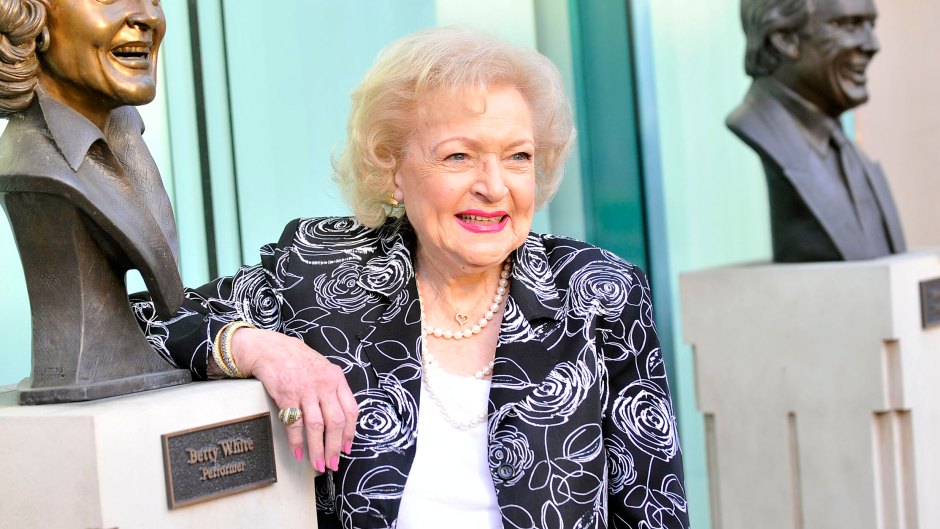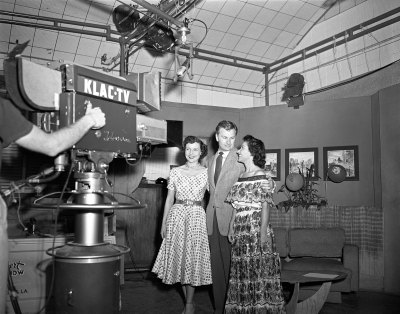
Getty Images
Betty White’s TV Career Began in the 1940s and Has Spanned Nearly Eight Decades
Making it big in Hollywood has never been easy, especially in the 1940s when finding work meant literally banging on doors. “I was so green that I didn’t even know on which doors to knock,” Betty White once recalled about her early days in showbiz. Occasionally, Betty saw a reward for her efforts. In 1948, she became one of four women hired to answer calls live on-air on Grab Your Phone, a quiz show on LA’s local KLAC-TV. “It must have looked like a tiny telethon,” remembered the future star, who stood out from the others by making jokes with the show’s emcee. At the time, it was perceived to be “a little out of character, a little unfeminine — you shouldn’t be funny,” said Betty, who didn’t care how it looked. “It’s so much more fun to get the laugh.”
It went against convention, but Betty’s quick wit on Grab Your Phone impressed LA radio personality Al Jarvis, who was planning his own daytime television program. He contacted Betty with an offer to become his “Gal Monday to Friday” on Hollywood on Television, a variety program that would air live for five and a half hours each weekday. With no script, Al needed Betty to help engage viewers with gossip, current events, off-the-cuff jokes, silly sketches and live commercials. For this, she would earn $50 a week.

Betty (far left) on Hollywood on Television in 1952. (Photo Credit: Getty Images)
Shortly after its November 1949 premiere, Hollywood on Television became such a runaway hit that KLAC-TV added a Saturday broadcast. Grateful for Betty’s invaluable talent and charm, Al increased her salary to a whopping $300 a week. “He was the best friend an employee ever had,” said Betty of her mentor, who over the next several years helped her hone her warm public persona. Betty would remain with Hollywood on Television through its four-year run and eventually take on the hosting duties herself — becoming America’s very first female daytime talk show presenter. In 1951, she also became the star of her own Sunday night vehicle, The Betty White Show. “I would read letters sent in by viewers and respond to their questions,” she said. “I would also sing a couple of songs.” Betty brought her dog Bandit to the set, and he became a fixture under her desk during the show’s limited run.
Her collaboration with Al also continued until 1951 — the pair even hosted a televised talent competition at one point — and he helped her develop the characters of Elizabeth and Alvin, who would eventually be spun into a domestic comedy called Life With Elizabeth in 1952 with show creator George Tibbles and co-producer Don Fedderson. “We formed our own little company,” said TV pioneer Betty, then 30, who named her new enterprise Bandy Productions after her beloved Bandit. Life With Elizabeth, a half-hour series broken into three slice-of-life sketches, caught on and earned Betty a regional Emmy for most outstanding female personality on television in 1952. “It was a first-class ego trip,” admitted Betty, who bested favored-to-win Zsa Zsa Gabor. “That lovely little statue is a genuine thrill that never goes away.”
Hollywood on Television ended in 1953 and Betty, with only Life With Elizabeth on her schedule, had time to pursue other options. She accepted when NBC ordered her a live national talk program called, once again, The Betty White Show, in which she would interview celebrities and sing. Network executive Tom McAvity christened her “television’s first sweetheart” and gushed that Betty “has that intangible something that appeals to the entire family.” However, Betty’s hot streak began to cool. Life With Elizabeth ended in late 1955 after 65 syndicated episodes. The Betty White Show performed well until NBC changed its time slot twice; it was canceled at the end of 1956 after exactly two years. “I was convinced it was the end of the world,” remembered Betty.
As 1957 dawned, Betty had a new show, Date With the Angels, and a new network, ABC. Like The Secret Life of Walter Mitty, the series followed the fantasy lives of married couple Gus and Vickie Angel. “We had a ball doing it,” recalled Betty. But when network sponsors balked at the fantasy segments, Date With the Angels “became one more run-of-the-mill domestic comedy,” she sayd. “We were plugging along and surviving — barely — but there was no longer any different spin on it, and as a result the fun was gone. That was the only time I have ever wanted to get out of a show.”

Betty with John Hillerman on The Betty White Show. (Photo Credit: Getty Images)
To fill the last 13 weeks of their contract, Betty and her partners created The Betty White Show (No. 3!). Each episode consisted of three unrelated sketches starring the actress and a repertoire of comedians with guest stars like Buster Keaton and Boris Karlo. “They were wonderful and entered into our nonsense wholeheartedly,” she said. As her commitment to the show ended in 1958, Betty found herself at a crossroads again. “I didn’t know that I was on the verge of a whole new chapter in my life,” said the star, who wouldn’t return to a regular role in a situation comedy for 15 years.
For more on Betty White, pick up the new issue of Closer Weekly, on newsstands now — and sign up for our newsletter!








































